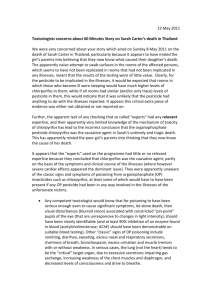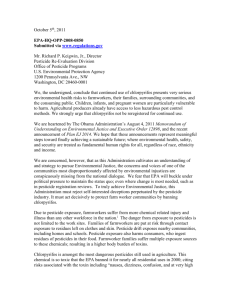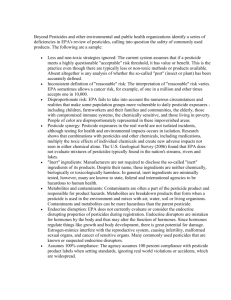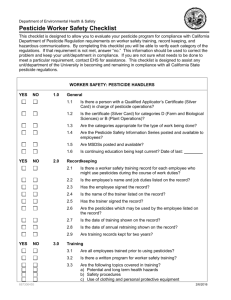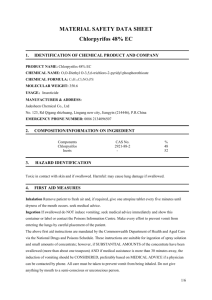media advisory - Californians For Pesticide Reform
advertisement
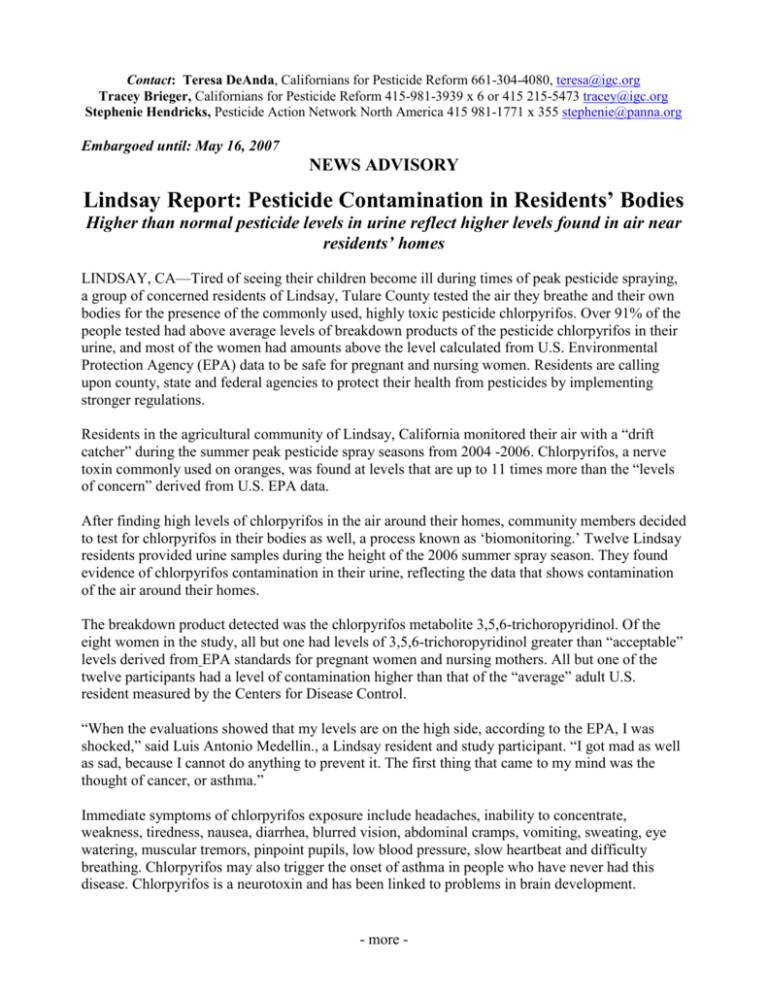
Contact: Teresa DeAnda, Californians for Pesticide Reform 661-304-4080, teresa@igc.org Tracey Brieger, Californians for Pesticide Reform 415-981-3939 x 6 or 415 215-5473 tracey@igc.org Stephenie Hendricks, Pesticide Action Network North America 415 981-1771 x 355 stephenie@panna.org Embargoed until: May 16, 2007 NEWS ADVISORY Lindsay Report: Pesticide Contamination in Residents’ Bodies Higher than normal pesticide levels in urine reflect higher levels found in air near residents’ homes LINDSAY, CA—Tired of seeing their children become ill during times of peak pesticide spraying, a group of concerned residents of Lindsay, Tulare County tested the air they breathe and their own bodies for the presence of the commonly used, highly toxic pesticide chlorpyrifos. Over 91% of the people tested had above average levels of breakdown products of the pesticide chlorpyrifos in their urine, and most of the women had amounts above the level calculated from U.S. Environmental Protection Agency (EPA) data to be safe for pregnant and nursing women. Residents are calling upon county, state and federal agencies to protect their health from pesticides by implementing stronger regulations. Residents in the agricultural community of Lindsay, California monitored their air with a “drift catcher” during the summer peak pesticide spray seasons from 2004 -2006. Chlorpyrifos, a nerve toxin commonly used on oranges, was found at levels that are up to 11 times more than the “levels of concern” derived from U.S. EPA data. After finding high levels of chlorpyrifos in the air around their homes, community members decided to test for chlorpyrifos in their bodies as well, a process known as ‘biomonitoring.’ Twelve Lindsay residents provided urine samples during the height of the 2006 summer spray season. They found evidence of chlorpyrifos contamination in their urine, reflecting the data that shows contamination of the air around their homes. The breakdown product detected was the chlorpyrifos metabolite 3,5,6-trichoropyridinol. Of the eight women in the study, all but one had levels of 3,5,6-trichoropyridinol greater than “acceptable” levels derived from EPA standards for pregnant women and nursing mothers. All but one of the twelve participants had a level of contamination higher than that of the “average” adult U.S. resident measured by the Centers for Disease Control. “When the evaluations showed that my levels are on the high side, according to the EPA, I was shocked,” said Luis Antonio Medellin., a Lindsay resident and study participant. “I got mad as well as sad, because I cannot do anything to prevent it. The first thing that came to my mind was the thought of cancer, or asthma.” Immediate symptoms of chlorpyrifos exposure include headaches, inability to concentrate, weakness, tiredness, nausea, diarrhea, blurred vision, abdominal cramps, vomiting, sweating, eye watering, muscular tremors, pinpoint pupils, low blood pressure, slow heartbeat and difficulty breathing. Chlorpyrifos may also trigger the onset of asthma in people who have never had this disease. Chlorpyrifos is a neurotoxin and has been linked to problems in brain development. - more - A phaseout of all domestic uses of chlorpyrifos was completed in 2005—a decision based largely on the health hazards it posed to children—yet chlorpyrifos is still widely used in agriculture where the threat of exposure remains high for rural residents, including children. “If the pesticide found in my body is banned for use inside homes, why is it still allowed to be used in fields right next to our homes?” asked Luz Medellin Rodriguez, one of the study participants. “It doesn’t make sense.” Community members now know that chlorpyrifos and other harmful chemicals from pesticides are contaminating their bodies and their air. They are asking authorities to establish buffer zones between residential areas and fields that are sprayed, and notification laws for applicators so that residents can be warned before spraying occurs. They are also asking for chlorpyrifos to be phased out by EPA and the California State Department of Pesticide Regulation for all agricultural uses. “I want the authorities to be conscientious and do something to protect our health,” commented Domitila Lemus, a Lindsay resident whose seven children attended Sunnyside School, a local school surrounded by orange groves. “They need to implement regulations that will restrict the use of pesticides near schools and towns, and they need to phase out the most dangerous pesticides.” Available for interviews: Irma Arrollo, President, El Quinto Sol de América, 559-827-7786, irma_medellin@yahoo.com Teresa DeAnda, Central Valley Representative, Californians for Pesticide Reform, 661304-4080 teresa@igc.org Dr. Margaret Reeves, Senior Scientist, Pesticide Action Network, 415 981-1771 ext 326 mreeves@panna.org Sharyle Patton, Director, Commonweal Health and Environment Program 415-868-0970 spatton@commonweal.org Gustavo Aguirre, Assistant Director of Organizing, Center on Race Poverty & the Environment (661) 667-0136, aguigustavo@gmail.com Additional Resources: Californians for Pesticide Reform: http://www.pesticidereform.org/ Commonweal Biomonitoring Resource Program: http://www.commonweal.org/programs/brc/index.html PANNA Drift Catcher Page: http://panna.org/campaigns/driftCatcher.html PANNA Organophosphate Page (Chlorpyrifos is part of a class of pesticides called organophosphates): http://panna.org/campaigns/ops.html PANNA Organophosphate Report Page – includes chlorpyrifos fact sheet http://panna.org/campaigns/opsReportFacts.html SAFE (Safe Air For Everyone) Campaign: http://www.pesticidereform.org/safe
